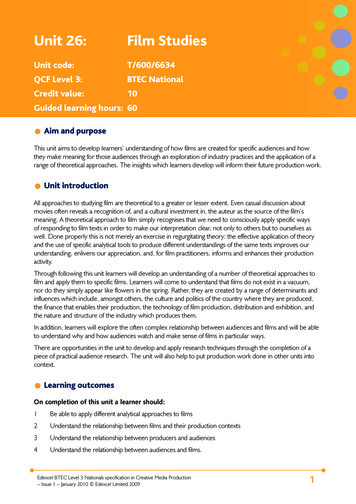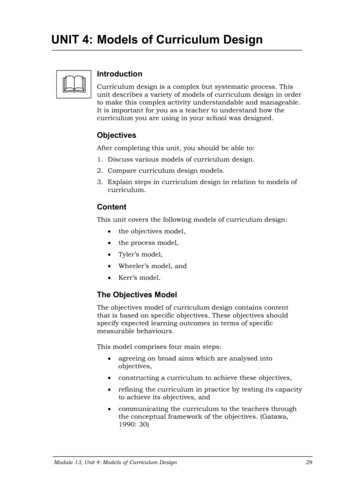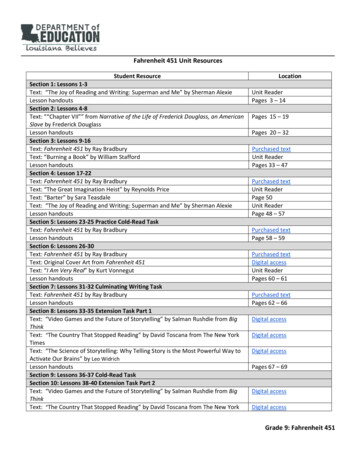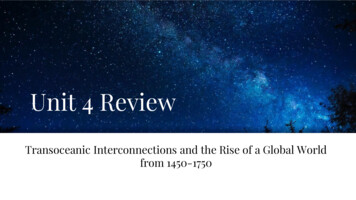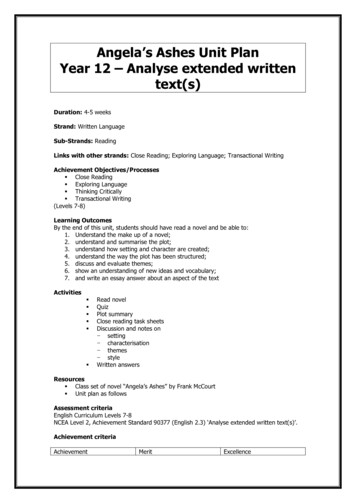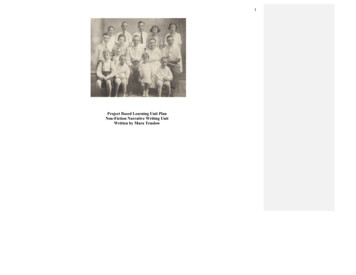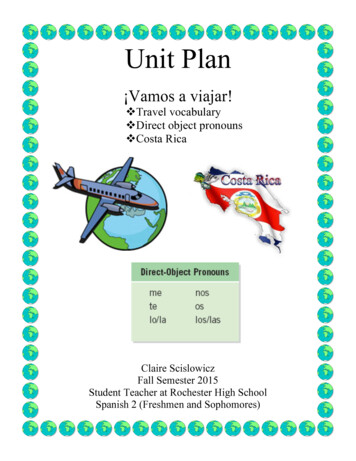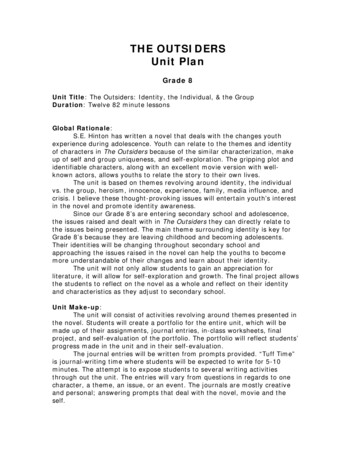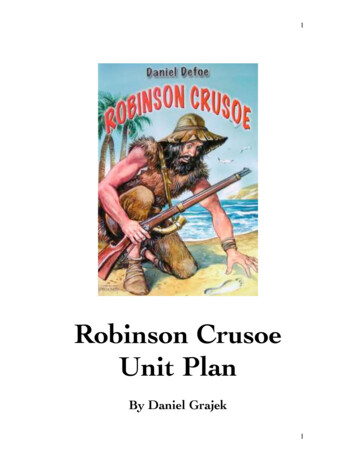
Transcription
1Robinson CrusoeUnit PlanBy Daniel Grajek1
2UNIT PLAN(General Information)TEACHER: Mr. Daniel GrajekGRADE/COURSE: Grade 9/ English 101THEME: Persons who possess the qualities of proactivity and humility can surviveand find success.MATERIALS (INCLUDING COMPANION LITERATURE):1. Robinson Crusoe by Daniel Defoe2. Hatchet by Gary Paulson3. List of unfamiliar words and definitions4. Screen/Projector/Computer with PowerPoint and MediaPlayer5. PowerPoint Slides6. YouTube links to video performances of (and related to) Robinson Crusoe7. Personal Journals8. The Picture Book of Robinson Crusoe by Elizabeth MooreASSESSMENT (GENERAL and SPECIFIC):1. Daily Quizzes2. Writing Assignment 1: Short Story3. Writing Assignment 2: Newspaper Article based on an interview4. Unit Project: Research paper (Heroes, or Critical Analysis of Robinson Crusoe)5. Unit Test (attached)6. ObservationREADING STRATEGIES1. Character Circle2. Impromptu Drama3. Guided Imagery4. Story QuiltWRITING STRATEGIES/SKILLS/ACTIVITIES1. Writing Workshop2. Process Writing3. Portfolio4. Journal Writing5. Environmental Journalism6. I-SearchVOCABULARY DEVELOPMENT:Weekly GlossaryORAL LANGUAGE DEVELOPMENT1. Making a Scene2. Accidental Power3. Change Agent2
34. Dramatic Monologue5. Value Chat6. Partner ProbeWEEK ONE:OVERVIEW/FOCUS:1. Students will recall general information about Robinson Crusoe2. Students will identify the novel’s Unit Theme3. Students will be able to connect Robinson Crusoe and Hatchet to their livesOBJECTIVES:Student will be able to:1. State the Unit Theme of Robinson Crusoe2. Write a 2 to 3 page short story about an experience (due first day of Week Two)3. Engage in discussions on subject matter from daily reading assignments4. Participate in a prewriting activity using Pair-and-Share5. Recall information about Robinson Crusoe on daily quizzes6. Apply literary term definitions to the novel7. Identify unfamiliar words in Robinson Crusoe8. Compose Journal entriesSTANDARDS: CE 1.1, CE 1.2, CE 1.3, CE 2.1, CE 2.2, CE 2.3, CE 3.2, CE 3.3MONDAY:OBJECTIVES:Students will be able to:1. Recall information about the Robinson Crusoe story and Unit Theme2. Relate Robinson Crusoe and Hatchet to their own livesMATERIALS:1. Robinson Crusoe by Daniel Defoe2. Hatchet by Gary Paulson3. Screen/Projector/Computer with PowerPoint and MediaPlayer4. PowerPoint Slides5. Personal Journals6. The Picture Book of Robinson Crusoe by Elizabeth Moore7. List of unfamiliar words and definitions (see Attachment A)8. During Reading Worksheet (see Attachment B)9. Paper10. PenPROCEDURE:1. Start with bell work when students write something in their Personal Journal.3
42. Pass out copies of the Robinson Crusoe and Hatchet. Distribute During ReadingWorksheets3. Lead-In/Motivation/Anticipatory Set: Show a YouTube video of the 1997Robinson Crusoe movie trailer.4. Ask students “Are you familiar with the story of Robinson Crusoe from books,movies, etc.? What do you think it would be like to be stranded on an island?What would you do to survive?”5. Show slides with images of newspaper articles with headlines like “Missing SkierRescued After 15 Days,” “Lost Boy Found.” etc. Briefly recount stories. Theidea is to connect Defoe’s story with real life.6. Teacher shares one of his own personal “survival” stories, such as coping withunemployment7. Briefly mention Hatchet (using slide with book cover). Quickly summarize.18. Teacher addresses class: “Each one of us probably has a story to tell about gettingstranded somewhere and being lost (physically or figuratively).” Teacherdiscusses thoughts and feelings people have when undergoing this kind ofadversity panic shock bewilderment despair etc.9. Critical questions are raised: In these difficult circumstances, do we give up, or dowe somehow find a way to carry on? Do we get bitter and negative, or do weacquire a positive attitude? Do we blame others and give up, or do we takeresponsibility for ourselves and do something? What thoughts are involved inmaking either choice?10. Define and explain the concept of Theme using a PowerPoint slide. Ask studentsif anyone can identify the Theme of Robinson Crusoe. Propose the followingTheme: Persons who possess the qualities of proactivity and humility can surviveand find success. 2 Have students write this down on their During ReadingWorksheet.11. Give a brief synopsis of Robinson Crusoe, 3 a man placed in a terrible situationbecause of his own choices (reckless adventurism and ambition for materialwealth). As we read, we witness how his struggle to survive leads to an internalconflicts and, finally, transformation—from anxiety and self-centeredness, tocontentment and faith.12. Show the beautiful illustrations from Elizabeth Moore’s The Picture Book ofRobinson Crusoe4 on PowerPoint slides (or overhead projector). Some of thepictures depict Crusoe in suspenseful situations, such as encounters with pirates,cannibals, and mutineers. The purpose here is show that Crusoe is a fun book toread.13. Whole group discussion: Spend the rest of the class discussing with studentsthoughts and questions they may have about the book.14. Teacher passes out the list of unfamiliar words in Robinson Crusoe to refer towhile reading the book. For homework, students will pencil underline unfamiliarwords not on the list. He appoints a student to be in charge of collecting thesewords.15. Quiz4
5ASSESSMENT:Students will be assessed with a short quiz to be handed in at the end of class:1. What is Robinson Crusoe generally about?2. What is the Theme of Robinson Crusoe?3. What can stories such as Robinson Crusoe and Hatchet teach us about ourselves?4. Based on what you know, what do you think would appeal to you about thesebooks?(After quiz is graded, it will be returned to students so it (and other quizzes) can beused as a study guide.HOMEWORK/ASSIGNMENT:Read chapters 1-2 of Robinson Crusoe, referring to list of unfamiliar words.Pencil underline unfamiliar words not on the list. Identify the setting referring tothe During Reading Worksheet. Read chapter 1 of Hatchet.TUESDAY:OBJECTIVES:Students will be able to:1. Recall the setting of Robinson Crusoe story2. Identify the protagonist and antagonist to Robinson CrusoeMATERIALS:1. Robinson Crusoe by Daniel Defoe2. Screen/Projector/Computer with PowerPoint and MediaPlayer3. PowerPoint Slides4. Personal Journals5. List of unfamiliar words and definitions6. During Reading Worksheet7. White board and marker8. Paper9. PenPROCEDURE:1. Start with bell work when students write something in their Personal Journal.2. Teacher asks students to express their reaction to last night’s reading assignment.3. Lead-In/Motivation/Anticipatory Set: Teacher tells the class a personal story thatrelates to the young Crusoe in Chapter 1 and 2.54. Ask class to take out their During Reading Worksheet and share what they thinknovel’s setting is. Discuss.5. Using PowerPoint slides, outline the setting of Robinson Crusoe (time, place,elapsed time, historical background). 6 Detail historical background about DanielDefoe, his life, and why he wrote the book. 7 Have student fill in the settingsection of the During Reading Worksheet. Also, teacher writes this on the whiteboard.6. Define with the class other literary terms on During Reading Worksheet.5
67. Identify and fill in items on the During Reading Worksheet that we may alreadyknow: protagonist and antagonist. Teacher writes answers on white board.8. Plot: Like other items on the During Reading Worksheet, the section on Plot willremain blank (we don’t know the climax and resolution yet). However, we canmake predictions. Use the Making the Scene model (Milner and Milner, 2008,269): have a group of strong readers read critical passages for Chapter 1 and 28 sostudents can speculate possible outcomes. Have a whole group discussion on this.9. Vocabulary review: Ask students to list the unfamiliar words not on theunfamiliar word sheet. (Appointed student will collect these words. The teacherwill include them in a revised sheet each week.)10. QuizASSESSMENT:Students will be assessed with a short quiz to be handed in at the end of class:1. What is the time, place, and historical background of Robinson Crusoe?2. Who is the protagonist and antagonist?HOMEWORK/ASSIGNMENT:Read chapters 3-4 of Robinson Crusoe, referring to list of unfamiliar words.Pencil underline unfamiliar words not on the list. Identify other characters (major,minor, dynamic, and static) and characterization. Read chapter 2 of Hatchet.WEDNESDAY:OBJECTIVESStudents will be able to:1. Identify the first of two elements of the Unit Theme—proactivity—in specificpassages2. Define and contrast the definitions of proactivity and reactivity3. Identify other characters (major, minor, dynamic, and static) and characterizationof main charactersMATERIALS:1. Robinson Crusoe by Daniel Defoe2. Audio version Robinson Crusoe by Daniel Defoe (various selections)3. Screen/Projector/Computer with PowerPoint and MediaPlayer4. PowerPoint Slides5. Personal Journals6. Lists of unfamiliar words and definitions in Robinson Crusoe (see Attachment A)7. During Reading Worksheet8. Paper9. PenPROCEDURE:1. Start with bell work when students write something in their Personal Journal.2. Ask students what they thought about last night’s reading selection6
73. Review homework: Help students identify other characters (major, minor,dynamic, and static) and characterization. After brief discussion, ask students tofill these in on their During Reading Worksheet4. Lead-In/Motivation/Anticipatory Set: Teacher asks the class to express theirreaction to last night’s reading assignment. Talk about Crusoe as an aspiring slavetrader but he himself is a “slave!” 9 Show this passage on a PowerPoint slideand highlight this point.5. Using a PowerPoint slide define the concept of Theme. Ask students if anyonecan identify the theme of Robinson Crusoe. Reiterate: Persons who possess thequalities of proactivity and humility can survive and find success. Make surestudents have this on their During Reading Worksheet.6. Using slides with illustrations, we explore the concept of proactivity, 10 the notionthat an individual can control what happens to him/her, even when facing themost difficult situations and obstacles. A real life example of proactivity is Dr.Viktor Frankl, who overcame despair and (probably death) in a Naziconcentration camp with his positive attitude (from Frankl’s book Man’s Searchfor Meaning). Proactivity is the opposite reactivity, when you give up by thinkingyou are a helpless victim of life’s circumstances. A reactive person blames theenvironment and other people for their misfortunes. In the story, Robinson Crusoemoves from self-pity and reactivity to proactivity, a chosen attitude that isessential for success.7. Play audio presentations11 of key passages from the book highlighting Crusoe’sprogression from a reactive to proactive attitude: (1) Crusoe’s initial fear anddespair when he arrives on the island12 (2) Insights he has about himself as hestruggles to survive13 (3) He, at last, finds peace of mind and contentment throughreligion.148. Vocabulary review: Ask students to list the unfamiliar words not on theunfamiliar word sheet. (The teacher will include them in a revised sheet.)9. QuizASSESSMENT:Students will be assessed with a short quiz to be handed in at the end of class:1. What does it mean to be reactive?2. What does it mean to be proactive?3. How did Robinson Crusoe demonstrate each of these attitudes? How didhe become proactive?4. Who are the characters (major, minor, dynamic, and static) andcharacterization of main charactersHOMEWORK/ASSIGNMENT:Read chapters 5-6 of Robinson Crusoe, referring to list of unfamiliar words.Pencil underline unfamiliar words not on the list. Identify the terrible thoughts hehad regarding his condition after the shipwreck and how he managed to comforthimself.15 Read chapter 3 of Hatchet.THURSDAY:7
8OBJECTIVESStudents will be able to:1. Identify the second of two elements of the Unit Theme—humility—in specificpassages2. Students define and contrast the definitions of humility and prideMATERIALS:1. Robinson Crusoe by Daniel Defoe2. Audio version Robinson Crusoe by Daniel Defoe (various selections)3. Screen/Projector/Computer with PowerPoint and MediaPlayer4. PowerPoint Slides5. Personal Journals6. Lists of unfamiliar words and definitions in Robinson Crusoe7. During Reading Worksheet8. Paper9. PenPROCEDURE:1. Start with bell work when students write something in their Personal Journal.2. Ask students what they thought about last night’s reading selection3. Lead-In/Motivation/Anticipatory Set: Teacher will show the video of the characterPhil from the movie Groundhog Day before and after his personal transformationto illustrate pride and humility164. Using slides with illustrations, we explore the concept of humility, which meansin the context of novel, the recognition of one’s limitations and total dependenceon nature and God. It is the opposite of pride, the overestimation of yourself, yourimportance and the command you have over others, nature, and God.5. Using slides, share examples of pride and humility in other literature (i.e. JeanValjean, Billy Budd, and Uncle Tom)6. Play audio presentations of key passages from the book highlighting Crusoe’schange from a self-centered willfulness to humility7. Group/Independent Work: (Prewriting: listing/note taking.) Students areinstructed to break up into groups of two using the Think-Pair-Share model (40).Each member, given five minutes, is asked to tell the other person a personal storyof “how you were stranded or lost, and how you survived.” After five minutes, theroles reverse. Students are instructed to return to their seats, and produce abrainstorming list of elements of the story they just told. (50)8. Whole Class Discussion: Students share their stories with rest of the class9. Vocabulary review: Ask students to list the unfamiliar words not
3 3 4. Dramatic Monologue 5. Value Chat 6. Partner Probe WEEK ONE: OVERVIEW/FOCUS: 1. Students will recall general information about Robinson Crusoe 2.



